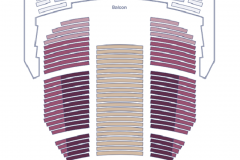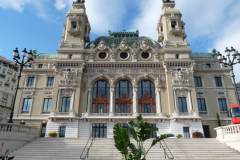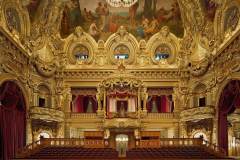Il trovatore
March 2026 | ||||||
|---|---|---|---|---|---|---|
Mo | Tu | We | Th | Fr | Sa | Su |
Drama in four parts
Music by Giuseppe Verdi (1813-1901)
Libretto by Salvatore Cammarano, completed by Leone Emmanuele Bardare, based on the drama El Trovador by Antonio García Gutiérrez
Premiere: Rome, Teatro Apollo, 19 January 1853
Production Opéra de Monte-Carlo,
in coproduction with Teatro Real de Madrid and Royal Danish Opera
Italians call Rigoletto, La traviata and Il Trovatore the “trilogia popolare”, an opera fan’s all-time favourites. The stories show Verdi’s passion for contemporary literature – Victor Hugo, Alexandre Dumas fils, the Spanish playwright Antonio García Gutiérrez –, and his fascination for characters from the edge of society. The deformed jester Rigoletto, the high-class escort Violetta Valéry, and the gypsy Azucena were considered unfit for principal roles in those days, especially when calling for your sympathy.
Il Trovatore is often ridiculised as a string of musical hits with a totally incomprehesible story. But when you boil it down, it is simple really: Two men fight for the love of a noble woman. One is a count, the other a gypsy soldier, but when in the end most of the main characters are dead, it turns out that the latter was the count’s long-lost brother.
The juxtaposition of female figures is great: the innocent object of desire, Leonora, tries to escape from her situation in the only ways possible for a girl of her standing – the monastery, and suicide. Azucena, on the other hand, is a magnificent portrait of a passionate, sometimes distraught, mature woman.
PLOT
Past History
Count di Luna, meanwhile deceased, had two sons. One day a gypsy was discovered standing beside the cradle of the younger son. When the child subsequently became ill, the woman was condemned to death at the stake for being a witch. The gypsy’s daughter, Azucena, thereupon abducted Luna’s younger son in order to burn him to death in the same place and thus take revenge for her mother’s death. However she mistook her own son for the boy she had abducted. In his place she raised Luna’s younger son as her own child and called him Manrico.
Civil war has broken out in Spain in connection with the crown of Aragon. Luna’s elder son is now the Count di Luna and is fighting on the side of the king. Manrico has joined the rebels.
Part One: The Duel
Ferrando, a captain in Luna’s army, tells the men in his service the story of the burning of the old gypsy and her daughter’s act of revenge. He is convinced that the old woman’s spirit is still haunting the earth.
Leonora is awaiting the arrival of her favourite suitor, the troubadour Manrico. She tells Ines how she met him at a tournament. Count di Luna, who is also in love with Leonora, declares his love. When Manrico’s voice is heard and Leonora hurries to meet him, she finds Luna, whom she has mistaken for Manrico in the darkness. Manrico and Luna realize that they are not only rivals for Leonora’s affection but also political opponents. They challenge each other to a duel.
Part Two: The Gypsy
Manrico has defeated Luna in the duel but was held back from killing him by an inner voice. In the ensuing struggle with Luna’s men he has been wounded. Azucena tells him the story of how her mother was burnt at the stake and her own act of revenge in which she burnt her own child instead of Luna’s son. She reacts with excuses to Manrico’s doubts and questions as to whether he is really her son. A messenger announces that Leonora, believing Manrico to be dead, has decided to enter a nunnery. Manrico decides to prevent this from happening.
Leonora mourns the death of Manrico. Luna has also heard about his beloved’s plans to become a nun and intends to abduct her. Manrico and his men, however, successfully seize Luna’s weapons and flee with Leonora.
Part Three: The Gypsy’s Son
Manrico has taken refuge with Leonora in a castle, which Luna’s soldiers are preparing to storm. Azucena has been taken prisoner, accused of being a spy. Ferrando recognizes her as the gypsy who abducted the count’s brother. When Azucena desperately calls out for Manrico it becomes clear to Luna that he has the mother of his deadly enemy in his power.
Manrico and Leonora are preparing their wedding when Ruiz, a soldier in his service, informs them that Azucena has been taken prisoner. Manrico calls his followers to arms and sets out to free the woman he believes to be his mother.
Part Four: The Execution
Manrico’s attempt to free Azucena has failed. He has also been taken prisoner. When Leonora hears that Luna is planning to have mother and son executed she begs him to set Manrico free and offers herself as the reward for Luna’s mercy. The latter agrees. Leonora secretly takes some poison in order not to have to keep her promise.
Manrico comforts Azucena, who longs to return home. Leonora urges him to flee immediately – she herself will remain, however. Manrico suspects what price she has paid to save him. Leonora dies. Luna realizes he has been deceived. He has Manrico executed immediately and forces Azucena to watch. She discloses the truth to him: „He was your brother!“
Program and cast
Production team
Conductor | Giacomo Sagripanti
Director | Francisco Negrin
Sets and Costumes | Louis Désiré
Lighting design | Bruno Poet
Choirmaster | Stefano Visconti
Repetitor | David Zobel
Assistant director | Jean-Michel Criqui
Cast
Count Luna | Artur Rucinski
Leonora | Pretty Yende (22, 24, 26 March) / Alexandra Marcellier (28 March)
Azucena | Varduhi Abrahamyan
Manrico | Piero Pretti
Ferrando | Evgeny Stavinsky
Inès | Annunziata Vestri
Ruiz | Reinaldo Macias
CHOIR OF THE OPÉRA DE MONTE-CARLO
ORCHESTRE PHILHARMONIQUE DE MONTE-CARLO
Opera de Monte Carlo
The Opéra de Monte-Carlo is an opera house which is part of the Monte Carlo Casino located in the Principality of Monaco.
With the lack of cultural diversions available in Monaco in the 1870s, Prince Charles III, along with the Société des bains de mer, decided to include a concert hall as part of the casino. The main public entrance to the hall was from the casino, while Charles III's private entrance was on the western side. It opened in 1879 and became known as the Salle Garnier, after the architect Charles Garnier, who designed it.
During the renovation of the Salle Garnier in 2004–05, the company presented operas at the Salle des Princes in the local Grimaldi Forum, a modern conference and performance facility where Les Ballets de Monte Carlo and the Monte-Carlo Philharmonic Orchestra regularly perform.

 EN
EN DE
DE IT
IT FR
FR ES
ES RU
RU JP
JP RO
RO
 Seating plan
Seating plan 
